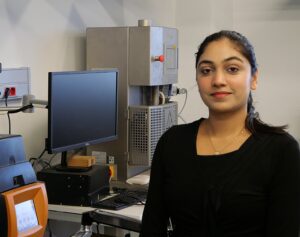
Sakshi Vijay Vijaya
EDUCATION
I hold a master’s degree in physics from India. Currently, I am pursuing my PhD at IMDEA Nanoscience.
PROJECT
My project title is First-Principles Calculations in Transition Metal Dichalcogenides (TMDCs). TMDCs are a fascinating class of two-dimensional materials that have attracted great interest due to their remarkable optical, electronic, and mechanical properties.
Depending on their composition and structure, they can behave as metals, semiconductors, or even superconductors, making them highly versatile for applications in electronics, optoelectronics, energy storage, catalysis, and quantum technologies. Studying these materials through computational techniques such as Density Functional Theory (DFT) provides valuable insights into their unique properties, such as tunable bandgaps, charge density waves, and layer-dependent behavior. By modeling the effects of external parameters like strain, doping, or twist angle, my research aims to uncover how these properties can be engineered for specific functions.
This not only deepens our understanding of the fundamental physics of TMDCs but also helps guide experiments and accelerate the design of next-generation quantum materials for advanced devices.
PI: José Ángel Silva.
Where do you come from?
I come from Kerala, India.
What are your main personal and professional concerns?
Personally, I value continuous learning and growth, and I am deeply motivated by curiosity about how the world works at the most fundamental level. Professionally, my main concern is to build a strong foundation in research that not only advances scientific knowledge but also contributes to technological progress. I am particularly focused on developing expertise in computational materials science so that I can bridge the gap between theory and experiment in understanding quantum materials.
What does your research consist on?
My research focuses on the study of two-dimensional quantum materials, particularly transition metal dichalcogenides (TMDCs). Using first-principles simulations, I investigate their structural and electronic properties to understand the underlying physics that governs their behavior. The goal is to explore how external factors such as strain, layer thickness, or twist angle can tune these properties, with the broader aim of guiding experiments and enabling the design of materials for future technologies in areas like electronics, energy, and quantum devices.
What power does science have to transform the world?
Nanoscience has the power to change the world by letting us shape and control matter at the level of atoms and molecules. This makes it possible to create new kinds of materials and devices, with uses in energy storage, sensors, computing, and quantum technologies. Being able to understand and control quantum effects on such a small scale is especially important for future technologies that can benefit fields like medicine, communication, and clean energy. In my work, I study these basic ideas and their potential for quantum technologies. I mainly use computer tools such as SIESTA and Quantum Espresso, and I collaborate closely with experimental colleagues to both guide their work through predictions and to help interpret their results.
Where do you find inspiration?
I first found inspiration during my master’s studies, when I had the opportunity to attend several scientific conferences. Listening to leading scientists present their research with
such clarity and passion motivated me to pursue this field. Those experiences opened my eyes to the vast potential of materials science—not only in advancing fundamental knowledge, but also in driving innovations with real-world applications. Conferences also showed me the importance of collaboration and knowledge exchange, where diverse ideas come together to solve complex problems. This inspired me to contribute to the field through my own research, with the hope of pushing the boundaries of what materials can achieve in the future.
Where do you see yourself in the future?
In the future, I see myself continuing in academia or research-intensive environments, leading independent projects in materials science and quantum technologies. I want to contribute not only by advancing knowledge but also by mentoring the next generation of scientists. I also aspire to bridge academia and industry, applying my expertise in computational materials to drive innovation in new technologies that address real societal challenges.
Why IMDEA Nanociencia?
I chose IMDEA Nanoscience because of its strong reputation in research on nanoscience and nanotechnology. The institute has excellent facilities that support both advanced experiments and theoretical studies. Through the IDEAL PhD program, IMDEA provides high-quality training and career development that are very important for building a successful research career. I am also drawn to its friendly and supportive environment, where working across different fields encourages new ideas and discoveries. IMDEA’s international outlook and diverse research community create a lively space for learning and collaboration. Altogether, I believe this combination of quality, teamwork, and global perspective makes IMDEA the best place for me to grow as a researcher and reach my goals.
